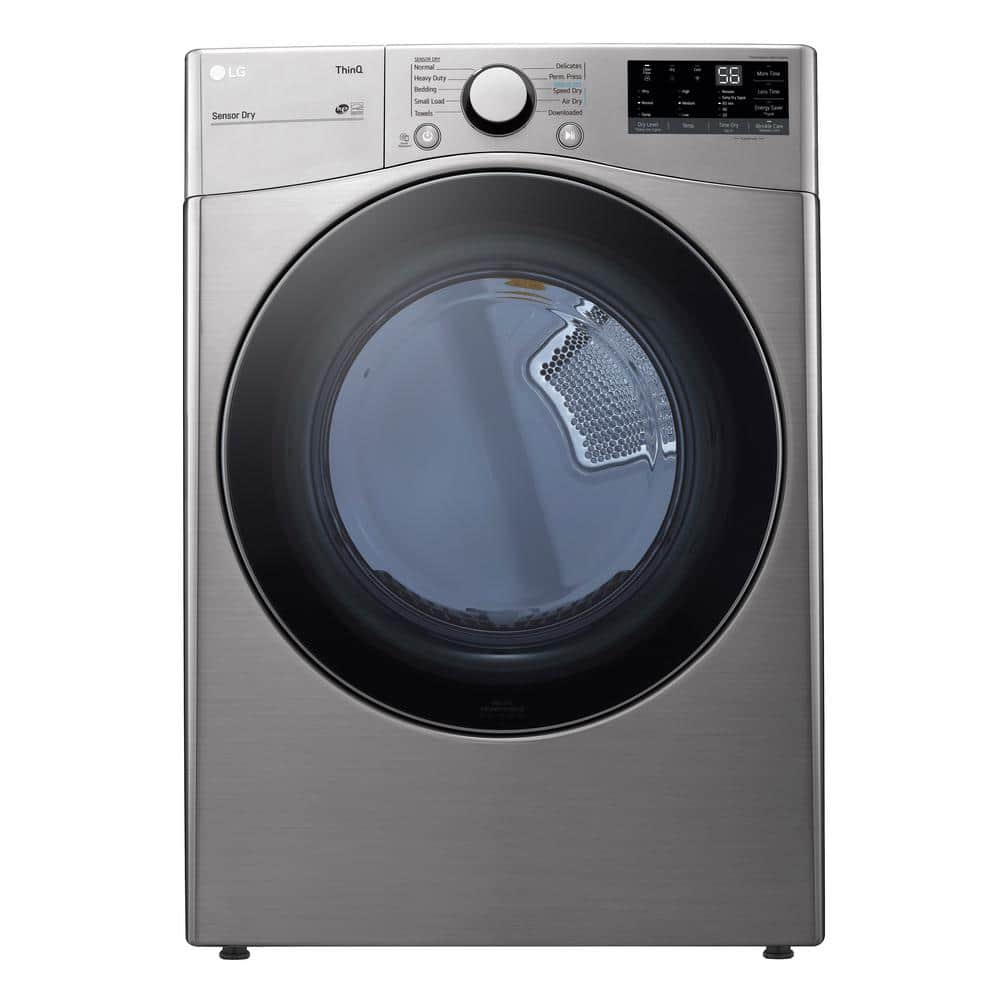LG Electronics 7.4 cu. ft. Graphite Steel Ultra Large Capacity Gas Dryer with Sensor Dry
7.4 cu. ft. pedestal compatible or stackable LG Gas Dryer. LG washer and dryer- pair w/ WM3600HVA washer. Built-in intelligence selects optimal dry motions and settings.
Tired of toggling through endless cycles only to have clothes come out damp or overdry. This dryer takes out the guesswork, with built-in intelligence that uses advanced sensors and AI technology to automatically select the right drying motions, temperatures and more. It can even talk to your washer to select a compatible cycle – so you don’t have to. What could be easier, use the ThinQ app to start or stop the dryer from anywhere, and even receive an alert when clothes are dry. Durable and stylish tempered glass door with white or silver accents adds the perfect finish.
- Free up your day-fit more clothes in every load with 7.4 cu. ft. of space, running fewer loads saves energy and money on your utility bill
- Built-in intelligence takes out the guesswork – AI technology selects optimal dry motions and settings; washer can auto select a compatible drying cycle
- ThinQ App controls laundry remotely and proactive customer care sends maintenance tips and alerts
- LG front load washers and dryers are the first to use tempered glass doors for a sleek, stylish look that resists shock and scratches; the premium feel is further enhanced by matching door trim and control knob accents; disclaimer: accent colors and finishes vary by model; door trim and matching control knob accents available in white/silver
- With the FlowSense duct clogging and clean filter indicators, you’ll know when it’s time to clean the ducts and the lint filter out to ensure great drying every time, lower utility bills and fewer service calls
- High efficiency sensor drying and low-heat settings save energy and money by using about 20% less energy than conventional models without sacrificing features or performance
- Handles surprisingly big loads with a compact, closet depth design that offers plenty of installation options.
- Aluminized alloy steel drum has toughness and an attractive finish that will last for years
- Designed for quiet operation, run the dryer without interrupting naptime or your favorite show
- Dryer door can easily be reversed from a right swing to a left swing in minutes to give you more installation options.
- Periodically tumbles dry for up to 3 hours after the cycle is done to help keep wrinkles at bay.
- Stackable with matching washer (WM3500CW) to conserve space within your laundry room with stack kit (model: KSTK1) sold separately
- 10 wash programs; normal, perm, press, heavy duty, delicates, towels, speed wash, bedding, tub clean, whites, additional downloadable programs also available
- 11 wash options; fresh care, prewash, remote start, delay wash, wi-fi, add, garments, coldwash, water plus, extra rinse, rinse plus spin, child lock
- All compatible LG washers, dryer, SideKick pedestal washers and laundry pedestals sold separately
- Installation is not available in all locations. See store for details.
Additional information
| Depth With Door Open 90 Degrees (In) | 51 |
|---|---|
| Door Opening Height x Width (In.) | 16.06 x 16.06 |
| Product Depth x Height x Width (in.) | 30.13 x 39 x 27 |
| Certifications and Listings | CSA Listed,Energy Star |
| Manufacturer Warranty | Parts and Labor 1 Year |






by Daniel
Disappointed that this dryer model has no interior light when the door is opened.
by Kim
I bought my new dryer in February and received it about a month ago. So far so god. It seems as though my clothes dry faster in this new machine.
by Phil
The Washer has a great style, it works well, is really quite, we are pleased with our purchase.
by Pommie
This is my second LG dryer and I love it. I can go the next day and get things out of the dryer and they are not wrinkled at all! I love the low heat settings it drys with and the sensors are right on. Thanks LG for a great product again!
by Mocar
purchased approx 2 weeks ago. so far happy with product
by Charlie
Perfect, no problem with large loads like King size comforter. Gas just a little loud.
by Kimberly
I had an older version of this that I loved and then it stopped working so I bought this new one. It has many great features that I loved on the old one. It is easy to use and dries clothes perfectly. I love the feature to minimize wrinkles if I can’t get my clothes out right away.
by Jan
I love my new washer and dryer! They are much more efficient than my old top loader and dryer, easier to use and more gentle on my clothes. The price at Home Depot was excellent, the delivery was fast, and the installation was smooth. Ordering online required a phone call since I needed help placing the order, but the customer service rep was friendly and efficient and we placed the order.